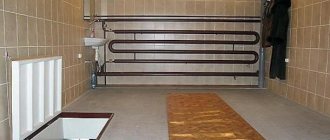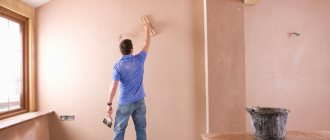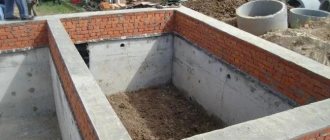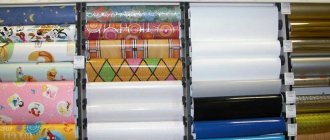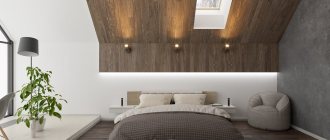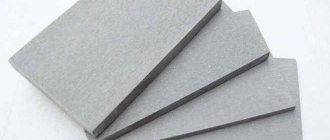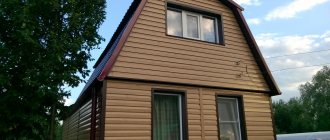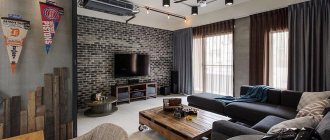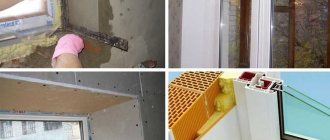The need to decorate the garage
The garage is built from the most available materials: silicate or red brick, concrete, foam concrete, cinder blocks. However, the characteristics of building stone are very different and are intended for use only in certain climatic regions. This creates the need for protection.
- The wall material - foam concrete, for example, has open pores. With high humidity and frequent rain, moisture penetrates inside and destroys the material. It must be protected from water. The same applies to gas silicate blocks and expanded clay concrete.
- Increased strength - a garage box in a common area must also be protected from the actions of hooligans.
- Aesthetics – a sloppy building next to a beautiful residential building looks unpresentable.
- Service life - if the façade and garage are not lined with clinker, which is rare, any finishing - clapboard, corrugated sheet, plaster - will extend its service life.
When covering a garage, they try to choose a relatively cheap option.
How to build a frame garage with your own hands
There is nothing difficult about building a garage yourself. This is a simple design that requires minimal effort. This does not require special equipment, there is no need to specially hire a team or draw drawings. If a place for construction is found, then decide on the size of the garage, clear the place of plants and create a gravel bed. The earth must be compacted. After this, construction can begin directly. It will consist of the following stages:
- Creating a foundation
- Frame assembly
- Roof construction
- Wall cladding
- Gate installation
Tools and building materials
We will need various materials. It will depend on what frame for the garage we choose.
Tools you will need:
- Hammer
- Shovels
- Level
- Gloves
- Formwork
It's minimum. Wood will be needed as a building material. It could be aspen, linden, larch. You will need beams with a cross section of 100x100, 100x50. To pour the foundation you will need to prepare a good concrete solution.
Requirements for external finishing
Materials for finishing the exterior of the garage must meet the following conditions.
- Simplicity in installation or installation - this is still a household building and spending a lot of time and effort on its cladding is unprofitable.
- Water resistance – the main destructive factor is high humidity, as well as rain and snow. Therefore, for construction it is better to choose materials that are insensitive to these factors, such as plastic siding or stone.
- Frost resistance is especially relevant for northern regions. This requirement is met by low-porous materials with a minimum expansion coefficient: clinker, steel siding.
- Aesthetics - even an outbuilding should look attractive - after all, this is a home for a car.
- Cost – affordable materials are preferable.
If the garage is located next to the house or attached to it, what kind of cladding to use is determined by the cladding of the building's facade.
Types of materials
You can sheathe the outside of a private garage with a variety of materials. Many of them have additional qualities.
- Brick or stone is an expensive, beautiful material that detracts from its excellent appearance. Clinker, facing bricks, artificial stone for finishing have minimal porosity, are resistant to frost, and are not afraid of water, snow, and sun. Disadvantage: complex and expensive installation, high price. There is one more feature: the stone weighs a lot, such cladding creates a high load on the foundation and walls and must be included in the project.
- Blockhouse is a variant of wooden lining. The finish has the same advantages as wood: environmentally friendly, beautiful, vapor permeable. However, she herself needs protection. The lining should be periodically painted, varnished or stained to increase its resistance to moisture. The peculiarity of the blockhouse is its shape. It imitates a log.
- Wooden lining is produced in a variety of form factors. It can have a flat surface, imitate timber, logs, or have complex terrain. The lining is a good heat and sound insulator and is quite resistant to mold. However, any version of it needs care.
- Plastering is the cheapest way to do it yourself. The plaster composition is resistant to moisture and can prevent water from entering the wall material. Decorative plaster provides an attractive design. Its main drawback is its fragility. Plastering has to be repeated once every 3–5 years.
- Finishing the garage with siding on the outside is the most common option. This is due to the variety of materials: metal, plastic, wood, and fiber cement siding are produced. They have different properties and are suitable for different conditions.
- Plastic sheathing is resistant to water and does not lend itself to any type of corrosion, but is sensitive to frost and not very durable. Metal siding is stronger and is not afraid of moisture, sun, water, or heat. However, it conducts heat and sound perfectly. Wooden is made from shavings and polymer resins, therefore it is much more resistant to moisture than natural wood. Fiber cement has all the advantages of the listed materials, but is heavier and creates a load on the wall.
- Sandwich panels are a finishing block that includes a base made of chipboard or plywood, a layer of insulation and a top layer - lining, siding, even clinker. Expensive material. They are sheathed with it if you need to insulate the garage.
Finishing can be done not only to protect the facade, but also to make it decorative. For this purpose, for example, jointing of brick walls is used. The work comes down to grouting the joints between the bricks with a lighter or darker contrasting paste. At the same time, the masonry seems more expressive, and the wall acquires a beautiful texture.
Other types of frame garages
Frame garages have become so popular that they are found on almost every site. Today you can find not only ordinary garages, but also large ones, for example, for two cars, or with an equipped attic. Building such a garage is a simple matter, which is why they are popular among summer residents and cottage owners.
DIY frame garage for two cars
This type of frame garage is as simple as a one-car garage. All construction steps are saved. The only thing that distinguishes such a garage is its width. In this case, proceed as follows: install a wall in the garage or do without it. In this case, when installing the roof, you will need to install another expansion beam. The rafter system is installed with a single identical step. Then the pressure will not be distributed over certain areas, but evenly.
DIY frame garage with attic
A frame garage with an attic is insulated much more seriously. During its construction, it will be necessary to insulate both the roof and the floor. Heating devices will also have to be installed. In such a garage it is good to carry out private repair work at home. As a rule, such buildings are found with two-car garages. The interior lining of the garage walls should be approached more constructively. Also use waterproofing material. It is not uncommon to create a similar structure based on a metal frame.
DIY metal frame garage
In our article we paid attention to the construction of metal garages, which are also easy to manufacture. When constructing them, sometimes they do without a monolithic foundation. You can use metal pipes and build a pile foundation. In this case, sand filling will have to be done to construct the floor. This type of garage can be built faster than a wooden one.
[ot-video type=youtube url=https://www.youtube.com/watch?v=MZQKjVR9OI0&feature=youtu.be] [ot-video type=youtube url=https://www.youtube.com/watch? v=wr-3ypIoNEo&feature=youtu.be]
Finishing stages
Covering a garage with siding or clapboard on the outside is not that difficult. However, such work, even without insulating the facade, requires time and effort.
- The walls are cleaned of dust and dirt, and the previous finishing – paint or plaster – is removed.
- The frame parameters are calculated based on the size of the lamellas and the area of the façade. Mark the mounting points on the wall.
- For the construction of external sheathing, a galvanized steel profile is used. The tree is allowed only as a last resort.
- Installation begins with the installation of the corner profile, starting and finishing strips. At the same stage, the door profile is assembled.
- The lamellas mature in length. The first element is snapped into the groove of the starting bar and secured to the frame with self-tapping screws. The fasteners are not rigid.
- Each subsequent lamella is inserted into the groove of the previous one and secured. The last element is snapped into the bottom one and inserted into the finishing strip.
Finishing the garage facade has different purposes: to protect the walls from rain and snow, to prevent wear and tear, to give the building an attractive appearance. The sheathing material is also selected in accordance with the requirements.
Garage exterior finishing
Have you already built your garage? If the foundation is ready, you have erected the box and completed the interior decoration of the garage, then all that remains is to take care of its appearance from the outside. After all, this will be the business card of your garage. It should look presentable and tasteful. If you are not a supporter of external beauty, then we want to assure you that decorating the outside of the garage is not done only for appearance. Thanks to this finishing, you can protect the walls of the garage from external influences and extend its service life for many years. Is this already interesting? If yes, then we invite you to find out what materials you can cover your garage with.
The matter is not limited to banal dyeing or applying a fur coat. There are really a lot of materials for work and they all have their own characteristics. Let's look at each of them separately.
Stage 3. Ceiling finishing
Ceiling made of corrugated sheets
After finishing the walls from the inside, you should pay attention to the ceiling. At this stage, the most relevant materials for finishing the ceiling are plaster and PVC panels
Typically, the choice of material for finishing the ceiling is determined by the presence or absence of ceilings in the garage and the garage owner’s own taste preferences.
If your garage does not have a ceiling, then you can only retain heat through internal wall cladding. Car enthusiasts often choose to finish the ceiling with clapboard. Why? Yes, because this particular material is economical, aesthetic and easy to install. In addition, it is worth considering that the ceiling covering is not, as a rule, subject to mechanical damage, as happens with the walls of the room.
If you would like to clarify details about a particular method of interior decoration, write comments to the article. Our experts will kindly answer all questions.
What is special about the exterior decoration?
It is important to consider this issue so that the material you choose does not lose its properties after a couple of months. What is the difference between the inside of a garage and the outside? The differences are obvious. Externally, the finishing will be constantly exposed to external influences. This includes precipitation, ultraviolet rays, constant temperature changes, mechanical and physical stress. All this will have a negative impact on the finishing material, and if it is not of the appropriate quality and characteristics, it will not serve you for long. Have you ever seen wallpaper being glued to the outside? That's funny. The same can be said about other materials.
Accordingly, the finish you choose should have the following characteristics:
- high moisture resistance;
- abrasion resistance;
- resistance to ultraviolet rays and temperature changes;
- high levels of frost resistance;
- strength and durability.
All materials must be for outdoor use. Only their manufacturers endow them with such qualities. Now let's look at what you can choose from.
Cheap and cheerful - painting the outside of the garage
It may sound trivial, but wall paint is a simple and reliable way to protect them. The main advantage of paint and varnish coatings as a finish is their low cost. The materials are sold at an affordable price, and even an inexperienced person can work with them. To work you will need a minimum set of tools and materials:
- The paint itself.
- Brush, roller with a tray or spray gun.
Everything is elementary and simple. Among other advantages, I would like to note a huge range of products, colors and shades. In addition, the paint can last quite a long time (if you choose it correctly). You can paint plaster walls, wood trim, brick and concrete. The paint will protect them from moisture and external factors.
Cladding options
You can get more information from the video in this article.
The garage should look presentable and not deviate from the style of the rest of the architectural ensemble.
Presentable garage building
The following options can be considered as finishing cladding solutions:
Coloring
Exterior paint
Using paint to finish exterior surfaces is one of the easiest ways to protect and decorate them. The main advantages of using paints and varnishes are their affordable price and ease of application.
Anyone can do this kind of work. In addition, to paint a building you will need very few equipment: a brush for cleaning the base, a roller for applying the composition, a paint tray and, in fact, the paint. You can also use a spray gun to speed up the process.
Application instructions are not particularly complicated:
- the surface is prepared, for which it should be cleaned and leveled;
- a primer is applied;
- Painting is carried out in several layers, with each of them drying.
This method can be used for wooden, metal or concrete buildings. The walls with applied plaster are also finished with paint.
Important! The paint must be intended for outdoor finishing.
The range of paints and varnishes allows you to choose the required shade and texture. A correctly selected composition will reliably and for a long time protect the structure from external destructive influences.
What you should pay attention to when choosing a material:
- resistance to ultraviolet radiation and temperatures;
- waterproof;
- strength;
- elasticity;
- lack of static attraction;
- degree of adhesion to materials.
For exterior work, it is recommended to choose acrylic, silicate, oil or silicone paints.
Applying plaster
Plaster composition for cladding
Cladding the external and internal walls of buildings with plaster has been and remains a popular finishing method. Thanks to these compositions, the surface can be leveled and an aesthetic, neat and durable coating can be created. In addition, the cost of materials and the ease of working with them allow anyone to use plastering of bases.
Available structural types, for example, “bark beetle”, allow you to create an interesting cladding. If desired, the treated walls can be finished with other types of coatings.
Plastering technology:
- the walls are cleaned: exfoliated surface fragments, defects and dirt are removed;
- the base is treated with a primer (its type is selected depending on the material from which the garage is built) containing fungicides and dried;
- starting plaster is applied, a reinforcing mesh is embedded in it, the surface is leveled;
- then a finishing composition is used (it can be decorative or textured), which is rubbed using a special tool.
Siding finishing
Using siding allows you to get a very presentable-looking structure. The material also performs a protective function, protecting walls and thermal insulation from the effects of weather.
Several types of coatings are produced:
Vinyl
Polyvinyl chloride coating
The material made from PVC is different:
- flexibility;
- ease;
- resistance to ultraviolet radiation, moisture and temperature changes:
- ease of installation.
Vinyl siding for garage
Metal
Wood-like metal panels
The covering can be made of aluminum or galvanized steel.
Despite the high cost, the material is attractive due to:
- corrosion resistance;
- absence of deformation due to temperature changes;
- fire resistance;
- durability;
- ability to withstand significant wind loads;
- a wide variety of shades and textures;
- ease of installation.
Cladding the garage with metal siding imitating the texture of a log
Cement, including with ceramic coating
Fiber cement coatings of various textures
The material is not as widespread on the market as the first two types, but there are prerequisites for its promotion. The cost of the coating falls into the budget category, and besides, the siding is environmentally friendly.
Cladding panels are made with the addition of fiber fiber, which increases the rigidity of the material. Cement siding is fireproof, lasts a long time and looks very attractive, but is quite expensive.
Fiber cement siding
How to sheathe the outside of a garage with corrugated sheets
To sheathe the outside of the garage, you need to purchase a profiled sheet of grade C or NS (wall). The numbers in the marking indicate the height of the wave. The best option is NS-20 grade corrugated sheet with a sheet thickness of 0.5 mm.
With corrugated sheets you can sheathe not only the walls, but also the roof. This material is suitable for making gates. Sheathing with corrugated sheets allows the use of insulation for garages used year-round.
Why sheathe garage doors?
As a rule, a garage built independently or purchased already has thermally insulated walls and a roof. At the same time, gates are the main source of heat loss. Therefore, insulating garage doors should be done without delay. Covering the doors will save on heating costs in winter and keep you cool on hot summer days.
Garage doors come in different types. One of the most common ones is made of a material having a three-layer structure (sandwich panels). This gate option is quite frost-resistant and moisture-proof; it will be quite warm in the garage. Meanwhile, metal gates cause the formation of ice during the cold season and require insulation.
Sandwich construction
During frosts, this type of shutter transfers cold air from outside into a room with a positive temperature.
Hinged door design
The resulting ice is fraught with the following negative consequences:
- rapid occurrence of rust on the doors;
- condensation settling on the metal body of the car. As a result, the car body becomes susceptible to premature corrosion;
- a large accumulation of layered ice mass that prevents the gate from opening.
Frame assembly procedure
Timely prevention of the problem will eliminate the mentioned consequences in the future. Therefore, it is better not to put off insulating the gate and quickly select a suitable material for covering.
Sectional Representative Scheme
Among the existing types of gates (swing, overhead, sectional), only swing gates are insulated. Other types of sashes are insulated during production with polyurethane foam panels 4.5 mm thick.
The modern market offers thermal insulation materials of several variations, which have many advantages, with a high coefficient of resistance to heat transfer and increased fire resistance.
Insulation with mineral wool
How to cover the outside of a garage with siding
Siding consists of separate panels that are fastened together with a lock. Siding panels are made from vinyl (the most budget option), aluminum, copper, cement, steel, ceramics, wood, etc. The length of the panels varies from 2 to 6 meters, it is easy to choose the best option in accordance with the dimensions of the garage. Siding panels usually imitate wood trim (ship plank, herringbone, blockhouse). You can even sheathe the outside of an iron garage with this lightweight material.
You can sheathe a garage with siding, as well as corrugated sheets, with or without insulation. The panels are installed on a metal (preferably) or wooden sheathing. The racks are fixed vertically (for horizontal siding) or horizontally (for vertical siding) to the walls through long dowel nails or by means of mortgages (when using insulation.
On a note! For Moscow, the Moscow region and other regions, it is recommended to pre-treat all wooden elements with an antiseptic to increase the service life of the finish.
The base flashing and the initial strip are attached along the lower edge of the wall, and special corner profiles are attached to the outer corners. Self-tapping screws are screwed into the holes along the edges of the profiles, and the self-tapping screw cannot be tightened too much; a gap is left between the head of the screw and the profile of up to 0.5-1 mm (the linear parameters of the profiles and the siding itself change at different air temperatures).
Siding panels are attached from bottom to top or from left to right (vertical).
The edge of the siding panel is inserted into the groove of the corner profile, after which it is fixed to the sheathing with self-tapping screws.
Important! When installing siding, it is important to check the horizontal position with a building level to prevent distortion. If the garage wall is long, a connecting profile is vertically attached in advance at the intended junction of the panels. Platbands are attached around the openings. And along the upper edge of the walls there are finishing profiles.
Choosing a material for finishing the walls inside the garage
A garage is a place where the car will be stored. Most people want to make this room as comfortable and safe as possible at minimal cost. How and with what can you decorate the walls in the garage? You will learn about this in this article.
Why do you need to finish a garage?
There are several cases when it needs to be trimmed:
- You bought a new garage with only bare walls.
- It is very cold in it, and you decide to insulate it.
- High percentage of heat loss.
- You want to improve conditions for storing vehicles.
- There is a lot of free space in the room, and you want to use it.
- The garage has a low fire safety rating.
- Routine renovation of the premises.
Finishing requirements
You need to treat all surfaces of the room and finish the floors. The most important thing is to choose the right materials, since the room is subject to physical and chemical effects.
So, the requirements for materials are as follows:
- They must be resistant to chemicals.
- Be non-flammable.
- Do not absorb dust, odors and small debris.
- Be resistant to impacts and scratches.
- It is good to withstand sudden temperature changes.
- Easy to use.
Suitable materials
There are many materials that can be used for decoration. You can choose them based on quality and price. If you need to finish the walls and ceiling, the following are suitable:
- Plaster.
- Ceramic tile.
- Polyvinyl chloride.
- Drywall.
- Wood chip boards.
- Plastic.
Suitable for the floor:
- Concrete.
- Ceramic tiles or asphalt.
- Tree.
- Self-leveling floor.
Calculation
To calculate the material correctly, you need to divide the area of all walls by the height of one wall.
Wall and ceiling treatment
When processing walls and ceilings, you need to choose the optimal solution based on personal preferences, budget size and combination of materials. Below are popular materials for finishing walls and ceilings that are popular among craftsmen.
Plaster
Contains sand and cement. The mixture protects well from fire, and you can also save money. The walls will not absorb dust and odors, are well resistant to temperature changes, and are also easy to repair.
The disadvantage is the difficulty of finishing. You must have certain skills and knowledge to do the job correctly.
After the plaster has dried, putty is applied to the walls in the garage. If you wish, you can simply paint the inside of the garage instead. You can paint the plaster walls in the garage with anything, but first use a primer.
Attention! Plaster is not recommended for use in cold weather.
Ceramic tile
Very durable and reliable. Easy to decorate and repair.
Disadvantages - the walls may not support the heavy weight of the tiles. Moreover, it is not cheap.
Processing with polyvinyl chloride panels
The material is quite easy to process. It does not burn and does not allow water to pass through. But these structures are inferior in strength. In addition, they are poorly resistant to cold.
Wood chip boards
Quite easy to install. But there are several disadvantages. The material burns well and allows water to pass through. You will have to regularly buy impregnation.
Drywall
Allows you to retain heat in the room. It doesn't burn well. Very durable. The disadvantage is that this finishing method is considered the most expensive.
Plastic linings
Easy to install. Pipes, ventilation, wiring and insulation can be installed under them. You can make a wall with gaps, or without.
This material is poorly resistant to impacts and melts easily.
Metal linings
The material is very strong and durable, does not burn and is resistant to temperature changes.
But the metal is highly corrosive and begins to rust when exposed to water.
Corrugated sheet
It is durable, cheap and easy to install.
The material is also highly susceptible to corrosion and rots when in contact with water.
Floor treatment
Concrete
Capable of withstanding heavy loads. Does not absorb dust. When treated with solutions, it can resist the absorption of odors and chemical elements. Low material cost.
But there is one drawback - the complexity of the arrangement.
Asphalt and ceramic tiles
Does not absorb odors and water.
Disadvantages - the material is quite expensive, difficult to arrange, and can also be damaged by impact.
Self-leveling floor
Its surface is smooth. It is impact resistant and has the same strength as concrete.
Disadvantages - the price is quite high, and the arrangement must be exactly down to millimeters, which is very difficult for a garage.
Tree
Environmentally friendly. Easy to arrange.
Lots of shortcomings. It is highly susceptible to fire, absorbs dust, water and odors and is not durable.
Which option is the best?
Of all the finishing methods listed, the best are concrete and plaster. If all the work was done to the highest possible quality, you will get a good result at the lowest price.
Finishing tools
Floor treatment instructions
So, all the materials have been purchased and you are ready to go.
Attention! If water constantly accumulates in the garage, slope the floors slightly.
The floor pouring process consists of the following steps:
- Making a sand pillow. It is necessary to fill the crushed stone to a height of several centimeters. Then - a layer of sand a few centimeters deep. Fill with water and level. Wait until the mixture is completely dry.
- Waterproof the garage walls. Polyethylene works well. 10 centimeters should be enough.
- Reinforcement. Necessary to increase the strength of concrete. To do this, a wire mesh is made. The cell size is about 10 centimeters. Bricks are suitable as fasteners. The guideline for installation will be iron pipes or wooden boards. Using formwork, install gaps from boards and fill them with insulation. This operation is necessary to ensure that the floor is very durable and does not freeze in winter.
- Now you can lay the concrete. Mix a solution of cement, water and sand in a container. When styling, use a vibrator to remove air from the mixture. Level it using the rule.
- Now you need to wait until the concrete dries. Cover it with film and water it with water. This will allow it to retain moisture. The structure will become completely durable in a month.
- Powder coat your garage.
Attention! This type of work is recommended to be done in the summer.
Wall and ceiling treatment
First of all the ceiling, and then the walls.
- Check the surface. Remove any high spots and caulk any low spots. Before doing this, wet the areas that you will be covering.
- Apply primer for good adhesion.
- Once the primer is dry, apply putty. It will take several layers, each one centimeter long. The first layer is needed for adhesion to concrete. The second is for alignment. The last one is for grouting.
- Excess dust and debris must be removed. Add some water or primer.
- Apply a final coat of putty to level the surface.
- Wait for the mixture to dry.
- Cover the walls in your garage with paint or primer.
You can also treat the garage externally. Suitable for this:
- Plaster.
- Vinyl siding.
- Cover the garage with clapboard.
- Stone processing.
Conclusion
As you can see, there are many ways to decorate a garage with your own hands. They all have their own advantages and disadvantages. You should choose the one that is most suitable for your space.
Cladding the garage with clapboard
Wooden lining is an environmentally friendly, very high-quality material that can advantageously transform the outside of a garage, and covering the walls with this material is not at all difficult. The outside of the lining is treated with antiseptics and fire retardants to prevent the material from drying out and rotting, as well as possible fire. Wooden siding is attached to the sheathing with nails or self-tapping screws all the way through the top edge.
Clapboard finishing, including blockhouses, is often used by owners of wooden houses to decorate buildings on the site in the same style.
Why re-tile a garage?
Sometimes the question may arise: why do you need exterior decoration of garage walls? It's not just about attractive appearance. Composite conditions for the car extend its service life and have a beneficial effect on operation. In addition, insulating and finishing the exterior of the garage maintains the quality of the structure and extends the life of the building. Garage owners are not always ready to allocate a large budget for such an event. There are inexpensive, practical and reliable finishes that meet all requirements.
Coloring
The most convenient and fastest way is to paint the outer walls of the garage. This method is suitable for buildings made of all types of materials, including metal, wood, plastic, brick. In some cases, for example, for metal garages, lengthy preparation is not even required: it is enough to sand and putty the uneven areas.
For other situations, the walls should be pre-plastered, after which a primer solution and the chosen paint should be applied. This method is quite lengthy and dusty, but it ensures that all required standards for the garage facade are met without spending a lot of money. This is also a chance to practice your plastering and painting skills. To give a more presentable appearance, you can choose “bark beetle” type plaster. If required, the garage is pre-insulated with foam plastic.
Using lining
In some cases, lining, which is made from coniferous and deciduous trees, is used to cover the outer walls of garages. It is a safe and natural material and has a special tongue-and-groove fastening, which makes it easy to connect the panels to each other.
There are several classes of lining, and the most ideal option is premium class material, which is characterized by excellent quality and a fairly high price, but it does not allow the presence of any defects or flaws on both surfaces. For a garage, you can use class A, which refers to the first grade and allows minor defects while maintaining the normal quality of the panels.
Siding
Insulating and covering garage walls with siding is a universal solution. This option will give an aesthetic and neat appearance and will comply with all SNiP recommendations. The most affordable and popular option is polyvinyl chloride siding. This is an easy-to-install material with high performance characteristics that does not require large financial investments. If desired, you can use wood or metal sheathing.
The siding is attached to a wooden sheathing, inside of which insulation is laid and a vapor barrier is fixed on top. Only after this are the siding panels installed. The method seems time-consuming, but it is much faster and cleaner to install than plastering and painting.
Features of siding application
Before sheathing the outside of the garage, you should familiarize yourself with the variety of siding, which includes the following types:
Vinyl siding is considered the most popular due to its reasonable cost and good performance characteristics. It is made from polyvinyl chloride, which is moisture resistant and has a simple installation method.
The main advantages include fire safety, resistance to temperature changes, a large selection of palettes, durability, and low weight of the panels.
Wooden siding is characterized by environmental friendliness, safety, and increased thermal insulation, but it has a high cost, so it is not advisable to use it for finishing a garage.
Metal siding differs from other types in its increased strength, resistance to temperature changes and mold, and in order to prevent corrosion, it is recommended to use self-tapping screws with a rubberized head.
Cement siding has significant weight, which creates an increased load on the garage foundation. Therefore, it is necessary to find out whether the walls and base of the garage can withstand such weight.
Joining seams
The most inexpensive and accessible way is to joint the brickwork. This method will add aesthetics to the appearance of the garage and will not require much effort or financial costs. This method, however, is only applicable to brick walls and is not suitable for garages made of other wall blocks or building materials.
There are other options: the use of sandwich panels, wooden lining, sheathing with corrugated sheets, finishing with artificial stone and brick. These are suitable options, but the high cost compared to the methods described excludes them as the most affordable.
Garage exterior finishing
Have you already built your garage? If the foundation is ready, you have erected the box and completed the interior decoration of the garage, then all that remains is to take care of its appearance from the outside. After all, this will be the business card of your garage. It should look presentable and tasteful. If you are not a supporter of external beauty, then we want to assure you that decorating the outside of the garage is not done only for appearance. Thanks to this finishing, you can protect the walls of the garage from external influences and extend its service life for many years. Is this already interesting? If yes, then we invite you to find out what materials you can cover your garage with.
The matter is not limited to banal dyeing or applying a fur coat. There are really a lot of materials for work and they all have their own characteristics. Let's look at each of them separately.
What is special about the exterior decoration?
It is important to consider this issue so that the material you choose does not lose its properties after a couple of months. What is the difference between the inside of a garage and the outside? The differences are obvious. Externally, the finishing will be constantly exposed to external influences. This includes precipitation, ultraviolet rays, constant temperature changes, mechanical and physical stress. All this will have a negative impact on the finishing material, and if it is not of the appropriate quality and characteristics, it will not serve you for long. Have you ever seen wallpaper being glued to the outside? That's funny. The same can be said about other materials.
Accordingly, the finish you choose should have the following characteristics:
- high moisture resistance;
- abrasion resistance;
- resistance to ultraviolet rays and temperature changes;
- high levels of frost resistance;
- strength and durability.
How to line a garage door from the inside
With internal insulation, low temperatures will affect the load-bearing part, but the dew point will not pass through the inner layer of insulation and will not affect the formation of condensation. Before sealing the garage door with insulating material indoors, take into account the location of the electrical wiring.
Most often, gates are insulated with the following thermal insulation materials:
- polystyrene foam;
- extruded polystyrene foam;
- penoizol.
Laying in prepared sheathing
Their thickness, depending on the region of use, should be at least 20 mm.
Next, we will consider each type of insulation in more detail.
Scheme of the main nuances of the assembly
Styrofoam
The bulk of the foam is occupied by gas, which causes toxic smoke during combustion. The material has a high resistance to heat transfer. It is incompatible with most paint and varnish products. Given the high flammability, polystyrene foam is placed between fire-resistant materials. Also, to reduce fire, fire retardant components of organic origin are added to it.
Fixing the material onto polyurethane foam
Extruded polystyrene foam
Refers to foamed types of insulation. It is a product of polystyrene and its derivatives. Extruded polystyrene foam consists of fine-cell granules. Its mechanical properties are determined by different densities. The denser the material, the lower its moisture permeability and higher strength.
This type of insulation is flammable, so when finishing it is placed between fire-resistant fittings. However, the flammability indicator in its labeling may vary. This material is widely used in thermal insulation of walls and internal barrier structures.
Urea-formaldehyde foam (penoizol)
It is similar to ordinary polystyrene foam in color and fine-cell structure. Transportation is carried out in liquid form. It is applied to the surface to be treated under pressure.
When in contact with oxygen, the product swells, filling the free space. When interacting with open fire, it deforms, but does not melt. Does not emit smoke or toxic gases.
Layout of materials
Having discussed the main properties of thermal insulation products, we move on to detailed instructions for the internal cladding process.
Photo of garage walls insulated with foam insulation.
Treatment of internal walls with foam insulation


